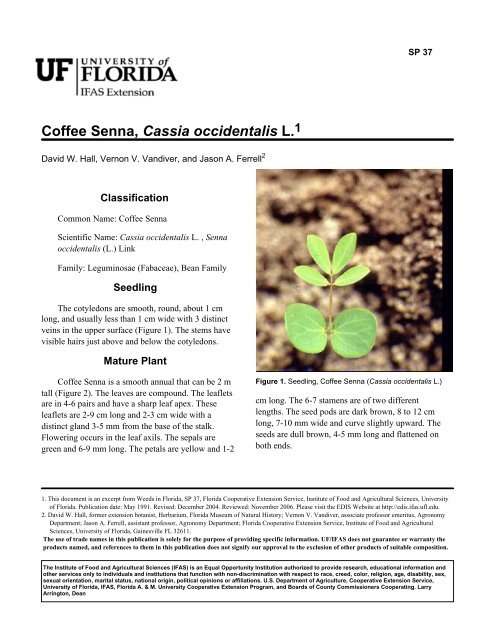Coffee Senna, Cassia occidentalis L. 1 - Orange County Extension ...
Coffee Senna, Cassia occidentalis L. 1 - Orange County Extension ...
Coffee Senna, Cassia occidentalis L. 1 - Orange County Extension ...
Create successful ePaper yourself
Turn your PDF publications into a flip-book with our unique Google optimized e-Paper software.
<strong>Coffee</strong> <strong>Senna</strong>, <strong>Cassia</strong> <strong>occidentalis</strong> L. 1<br />
David W. Hall, Vernon V. Vandiver, and Jason A. Ferrell 2<br />
Classification<br />
Common Name: <strong>Coffee</strong> <strong>Senna</strong><br />
Scientific Name: <strong>Cassia</strong> <strong>occidentalis</strong> L. , <strong>Senna</strong><br />
<strong>occidentalis</strong> (L.) Link<br />
Family: Leguminosae (Fabaceae), Bean Family<br />
Seedling<br />
The cotyledons are smooth, round, about 1 cm<br />
long, and usually less than 1 cm wide with 3 distinct<br />
veins in the upper surface (Figure 1). The stems have<br />
visible hairs just above and below the cotyledons.<br />
Mature Plant<br />
<strong>Coffee</strong> <strong>Senna</strong> is a smooth annual that can be 2 m<br />
tall (Figure 2). The leaves are compound. The leaflets<br />
are in 4-6 pairs and have a sharp leaf apex. These<br />
leaflets are 2-9 cm long and 2-3 cm wide with a<br />
distinct gland 3-5 mm from the base of the stalk.<br />
Flowering occurs in the leaf axils. The sepals are<br />
green and 6-9 mm long. The petals are yellow and 1-2<br />
SP 37<br />
Figure 1. Seedling, <strong>Coffee</strong> <strong>Senna</strong> (<strong>Cassia</strong> <strong>occidentalis</strong> L.)<br />
cm long. The 6-7 stamens are of two different<br />
lengths. The seed pods are dark brown, 8 to 12 cm<br />
long, 7-10 mm wide and curve slightly upward. The<br />
seeds are dull brown, 4-5 mm long and flattened on<br />
both ends.<br />
1. This document is an excerpt from Weeds in Florida, SP 37, Florida Cooperative <strong>Extension</strong> Service, Institute of Food and Agricultural Sciences, University<br />
of Florida. Publication date: May 1991. Revised: December 2004. Reviewed: November 2006. Please visit the EDIS Website at http://edis.ifas.ufl.edu.<br />
2. David W. Hall, former extension botanist, Herbarium, Florida Museum of Natural History; Vernon V. Vandiver, associate professor emeritus, Agronomy<br />
Department; Jason A. Ferrell, assistant professor, Agronomy Department; Florida Cooperative <strong>Extension</strong> Service, Institute of Food and Agricultural<br />
Sciences, University of Florida, Gainesville FL 32611.<br />
The use of trade names in this publication is solely for the purpose of providing specific information. UF/IFAS does not guarantee or warranty the<br />
products named, and references to them in this publication does not signify our approval to the exclusion of other products of suitable composition.<br />
The Institute of Food and Agricultural Sciences (IFAS) is an Equal Opportunity Institution authorized to provide research, educational information and<br />
other services only to individuals and institutions that function with non-discrimination with respect to race, creed, color, religion, age, disability, sex,<br />
sexual orientation, marital status, national origin, political opinions or affiliations. U.S. Department of Agriculture, Cooperative <strong>Extension</strong> Service,<br />
University of Florida, IFAS, Florida A. & M. University Cooperative <strong>Extension</strong> Program, and Boards of <strong>County</strong> Commissioners Cooperating. Larry<br />
Arrington, Dean
<strong>Coffee</strong> <strong>Senna</strong>, <strong>Cassia</strong> <strong>occidentalis</strong> L. 2<br />
Figure 2. Mature plant, <strong>Coffee</strong> <strong>Senna</strong> (<strong>Cassia</strong> <strong>occidentalis</strong><br />
L.)<br />
History<br />
<strong>Cassia</strong> is ancient Greek for a particular aromatic<br />
plant. <strong>Senna</strong> is an ancient Arabic name for these<br />
plants. The Latin word <strong>occidentalis</strong> means western,<br />
and refers to the origin.<br />
Habitat<br />
C. <strong>occidentalis</strong> is widespread in warm areas of<br />
the world except for Australasia.<br />
Biology<br />
On two different soil types growth was greater<br />
the higher the pH, 4.7-6.3. The seeds are known to be<br />
weakly toxic to various stock animals. Animals<br />
normally avoid ingesting these seeds. Increased<br />
germination is obtained by seed scarification.<br />
Control<br />
Peanuts<br />
There are effectively no preemergence herbicides<br />
that provide highly effective coffee senna control.<br />
Pursuit, applied preemergence, will deliver<br />
approximately 70% control, but all other herbicides<br />
will provide 50% control or less.<br />
The most effective herbicide combination is<br />
paraquat plus Basagran or Storm applied at-cracking.<br />
These combinations will commonly control greater<br />
than 90% of all coffee senna present at time of<br />
application; no soil-residual activity will be observed.<br />
Conversely, paraquat applied alone will not<br />
satisfactorily control coffee senna. Postemergence<br />
applications of Cadre or Basagran are effective<br />
against coffee senna. Although Cadre and Basagran<br />
will generally not provide 100% control, 80 to 90%<br />
control is commonly observed.<br />
Cotton<br />
Staple has been shown to provide good control<br />
of coffee senna when applied preemergence. All<br />
other preemergence herbicides are considered<br />
ineffective. Although sicklepod and coffee senna are<br />
closely related species, Cotoran does not possess<br />
adequate levels of coffee senna activity, as is<br />
commonly observed with sicklepod. Postemergence<br />
applications of glyphosate and/or Staple provide<br />
greater than 90% control of coffee senna. All<br />
postemergence directed herbicides, except Cobra and<br />
MSMA, provide greater than 90% coffee senna<br />
control.

















